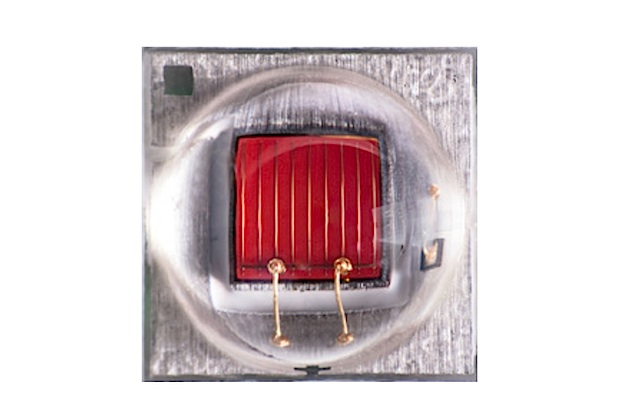The Cree XP-E has been the reefing industry workhorse for the longest time (relatively speaking) when it comes to colors outside of white and royal blue, although it has done pretty well in those roles too. Seeing as the white XP-E got a silicon carbide update late last year (which we covered here), Cree felt it was time to show some love to it’s color counterparts. Announced today, the XP-E2 Color lineup turns things up a few notches. As usual, we will get into the nitty gritty of how this LED changed from it’s previous generation, and how it stacks up to the competition.
Some features of the Cree XP-E2 LED haven’t changed that much. Thermal resistance values haven’t deviated all that much for the royal blue, blue and green LEDs, but red, red-orange, and amber have all seen a decrease, making them more efficient at getting heat out of the LED. Temperature coefficient also hasn’t changed that much either. Viewing angle has a slight increase to 135 degree (vs 130 degrees), but that won’t change performance much for us.
There hasn’t been a clear improvement across the board on forward voltage. This is usually where we see some decent gains when moving from one generation to the next. Typical values for a given current haven’t changed really for blue and royal blue, save for a 0.1v drop at 1000mA. Green has seen a 0.1v drop across all currents, while amber, red-orange, and red actually had a 0.1v increase. It’s certainly not the end of the world, and just shows that the new chip structure has a few caveats.
The big changes here are with current. Unlike the previous generation, all color LEDs are rated to 1000mA constant operation. That’s not a change for the blue, royal blue, and green LEDs, but this is a big change for amber (used to be 500mA), red-orange, and red (both used to be 700mA). Amber, red-orange, and red aren’t usually used in large quantities or high intensities in reef fixtures, so the extra current headroom (and resulting output) isn’t a huge deal, but it does make life easier for the DIYer who has to think about maximum drive currents like this for driver selection. Bumping the maximum current up will certainly make it easier to integrate these LEDs into fixtures.
So now that the current has been increased, what about the output? Fortunately, Cree found it in their heart to offer higher output bins for nearly the entire lineup.
As you can see above, there are some nice gains to be had with the new SiC platform, as well as the raised current limit for the amber, red-orange, and red LEDs. It’s not all sunshine and lollipops though, as this new chip design seems to have some issues with droop. Droop is the effect that heat has on an LED that reduces it’s output as the temperature increases. It’s one of the things that usually steadily gets better as LED technology progresses. In this case, it seems as though it was one of the trade-offs for increased overall output.
Royal blue was the biggest surprise, taking a 10 point hit compared to it’s predecessor (~75% of it’s rated output at 150C, vs. ~85% for the XP-E). Amber has always done poorly at higher temperatures (drops to ~10% of it’s rated output at 150C), so there is no real surprise there. Red-orange drops from 38% to 32%, red freefalls from 48% to 32%, and green only falls 1 point to 74%. The only improvement shown out of the entire lineup was with the blue LED, moving from ~86% at 150C, to a very impressive 94%. Throw as much heat as you like at that one, it’s not going to loose much output. Hopefully Cree can learn from the differences there, and improve the droop performance of the other LEDs.
One last thing to touch on is the distribution pattern of these new LEDs. As you can see from the above image, it seems like this new chip design is offering a slight change. It’s not quite as dramatic as the XT-E, but it’s a plus none the less. Normally, it would look much like you see for the amber, red-orange, and red LEDs, with a smooth bell curve. The new blue, royal blue, and green LEDs all have a pronounced increase in intensity through most of the viewing angle, but with a notable increase +/- 50 degrees off center. This should offer more even output, with less hot spots.
So, how does this compare to the competition like the Luxeon Rebel, or the XT-E royal blue? The XT-E with the 600mW bin comes in a about 1410mW, just a hair over the XP-E2, but that’s at 85C. When the playing field is leveled (bringing the XP-E2 up to 85C), the XP-E2 drops to about 1225mW. Compared to the Luxeon Rebel ES royal blue, it falls a little short at 25C, with the ES weighing in at 1500mW. Again, it’s tested at 25C, so when we bring that up to 85C, we’re down to 1410mW putting it on par with the XT-E. The rest of the colored LEDs all have a leg up compared to the Luxeon Rebels of equivalent color. The difference in performance increases greatly at higher currents, as the Rebel amber, red-orange, and red are still limited to 700mA.
What we have here then is a pretty decent upgrade over the original XP-E, with a few shortcomings. Fortunately, those shortcomings aren’t really deal breakers in the grand scheme of things, but they may be something to keep an eye on, especially if die temperatures start to climb. Press release and datasheet links can be found below.






